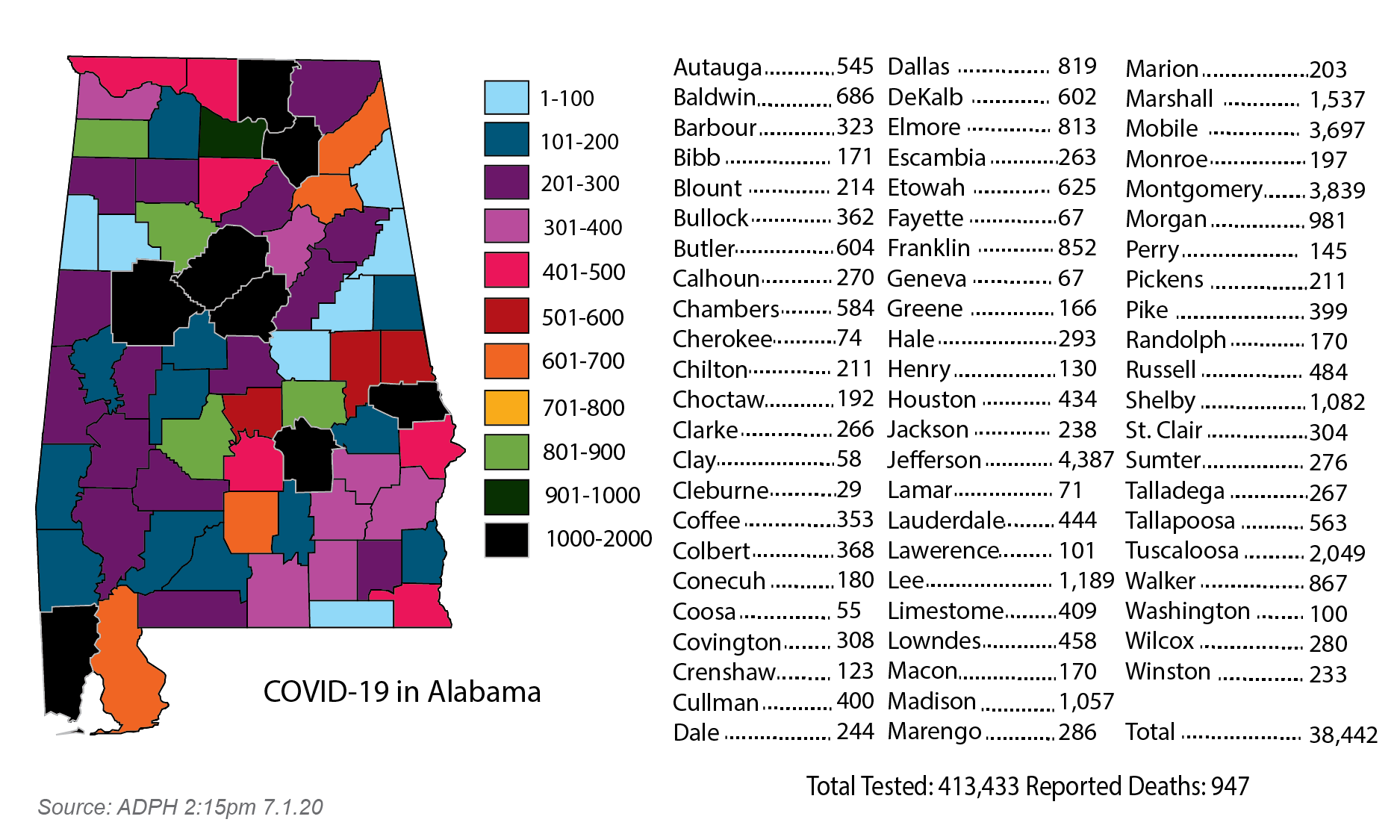New dashboard identifies county-level trends
Published 5:24 pm Wednesday, July 1, 2020
|
Getting your Trinity Audio player ready...
|
Pike County is considered at “moderate” risk in the Alabama Department of Public Health’s new color-coded COVID-19 guide.
The new dashboard provides a color-coded overview of the spread of COVID-19 in each Alabama county. The counties are ranked in four categories: green for low risk; yellow for moderate risk; orange for high risk; and red for very high risk.
As of 10 a.m. Wednesday, Pike County had 399 confirmed cases of COVID-19, with 5 deaths.
Statewide, Alabama has 38,442 confirmed cases with 947 confirmed deaths and an estimated 18,866 recoveries. The state. Has added 10,696 cases in the past 14 days.
The colors on the new map are assigned based on the rate of increase or decrease of new cases in each county, said Dr. Scott Harris, Alabama State Health Officer. The levels are:
• Red, for counties with steady or increasing numbers of new cases;
• Orange, for counties with decreasing case counts for 1 to 6 days;
• Yellow, for counties with decreasing case counts for 7-13 days;
• Green, for counties with decreasing case counts for 14 days or more.
The state is using a three-day average of number of new cases per day to determine each county’s status.
As of Wednesday, Pike County has added 55 cases in the past 14 days, a significant decline in rate from one week ago.
“Pike County seems to be moving in the right direction,” said Troy Mayor Jason Reeves. “We just need to make sure we continue to head in that direction.”
Reeves urged continued caution and safety guidelines including maintaining social distance; frequent hand washing; wearing masks in public or uncontrolled situations; staying at home if you are sick or awaiting COVID-19 test results; and staying at home and isolated from others if you test positive for the disease.
“This is something we’ve got to deal with,” he said. “It’s real, it’s not going away … people just have to continue to be responsible.”
The ADPH also released guidelines based on the new coding system. The recommendations include:
Red – Very High Risk
• Wear face coverings where other social distancing measures are difficult to maintain.
• Even when visiting family or friends, wear face coverings when within 6 feet of people outside your household.
• Avoid all unnecessary travel. If you must travel, avoid crowded areas if possible.
• Telework if possible. If not, maintain a 6-foot distance from others and wear face coverings at work.
• Takeout, pickup or delivery from restaurants is strongly encouraged rather than dining in.
• Avoid groups of more than 20 people.
• Avoid unnecessary visits to hospitals, nursing homes or other residential care facilities.
• Worship online or keep 6-foot distances between people of different households.
• Children with COVID-19 should stay home or be sent home for school or child care if showing symptoms. Limit public interaction between children and do not allow children on public playgrounds.
Orange – High Risk
• Continue social distancing at work, work from home when possible, and wear face coverings at work when social distancing is impossible.
• Limit out-of-state travel.
• Takeout, pickup or delivery from restaurants is encouraged rather than dining in.
• Maintain social distancing during outdoor recreation.
• Hold online workshop services if possible. When meeting in person, keep 6-foot distances between people of different households, consider holding more services for lower attendance, and more spacing between people at each service.
• Keep children away from in-person playdates or similar activities outside of the school setting if avoidable and do not allow children on public playgrounds.
Yellow – Moderate Risk
• Avoid groups of more than 50 people.
• Keep 6-foot distances from people outside your household in theaters and other entertainment venues.
• Check for fever, coughing or other symptoms of COVID-19 before team games or practices.
• Hold online worship services if possible. When meeting in person, keep 6-foot distances between people of different households; consider holding more services for lower attendance, and more spacing between people.
• Children should keep 6-foot distance from others outside their household, those with symptoms of COVID-19 should stay home from school or child care, limit interaction between children at playgrounds and other public places.
Green – Low Risk
• Continue social distancing at work and wear face coverings at work when social distancing is impossible.
• Large gatherings and venues are allowed with increased hygiene measures, physical distancing, face coverings and symptom monitoring.
• Check for fever, coughing or other symptoms of COVID-19 before team sports or practices. ·Stay home if sick.
• Places of worship are encouraged to consider social distancing, hygiene measures and face coverings.
•Children should follow hygiene measures, physical distancing, wear face coverings and monitoring for symptoms are encouraged for all group gatherings.





